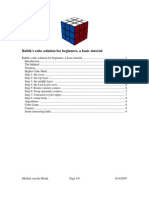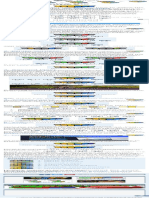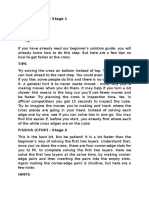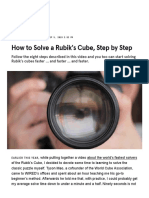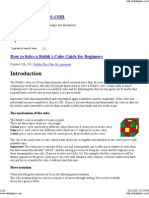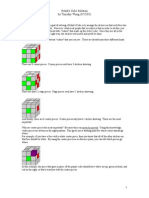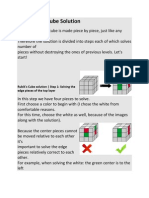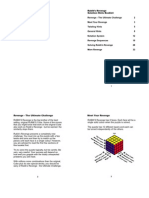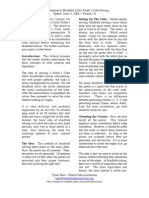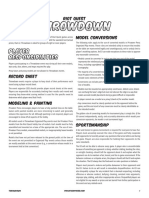Notation: It Is Important To Remember That The Moves Are Done If You Were Looking Directly at The Face
Notation: It Is Important To Remember That The Moves Are Done If You Were Looking Directly at The Face
Uploaded by
April MontoyaCopyright:
Available Formats
Notation: It Is Important To Remember That The Moves Are Done If You Were Looking Directly at The Face
Notation: It Is Important To Remember That The Moves Are Done If You Were Looking Directly at The Face
Uploaded by
April MontoyaOriginal Description:
Original Title
Copyright
Available Formats
Share this document
Did you find this document useful?
Is this content inappropriate?
Copyright:
Available Formats
Notation: It Is Important To Remember That The Moves Are Done If You Were Looking Directly at The Face
Notation: It Is Important To Remember That The Moves Are Done If You Were Looking Directly at The Face
Uploaded by
April MontoyaCopyright:
Available Formats
Notation
There is a notation used in describing the movements you are doing on the cube:
Front layer: F
Back layer: B
Top layer: U
Bottom layer: D
Right layer: R
Left layer: L
In a sequence, each of these letters tells you to move the corresponding face 90
degrees clockwise. A letter with an apostrophe, e.g. U', tells you to move that face
anti-clockwise. These would be said 'anti-up'. A letter with a 2, e.g. U2, tells you to
move that face twice in either direction, as direction doesn't matter.
It is important to remember that the moves are done if you were looking directly
at the face.
These letters are used in sequences known as algorithms, which are sets of
instructions that achieve a specific goal. For example, from a solved state the
algorithm F2 B2 U2 D2 L2 R2 would achieve a pretty pattern like such:
Other, less common letters for notation include M, E, S, x, y, z and lower case for all
of the normal faces.
M: Layer between L and R
E: Layer between U and D
S: Layer between F and B
x: Rotate the cube up (as if you are doing R, but move the whole cube)
y: Rotate the cube to the left (like doing U, but move the whole cube)
z: Rotate the cube on its side to the right (like doing F, but move the whole cube)
A lower case letter of any normal face means turn two layers, i.e. the one you are
turning and the middle layer next to it at the same time:
f: F and S
b: B and S
u: U and E
d: D and E
r: R and M
l: L and M
We will only be using the standard 6 for the beginner's guide.
Also, each individual piece is called a 'cubie'.
Beginner Method
Solving a Rubik's Cube is usually done layer by layer. Trying to do it face by face
would be nigh impossible, as you couldn't do the other faces without screwing up
the ones you may have already done.
I will cover three ways of solving the Rubik's Cube: beginner, intermediate and
advanced, and I advise you to start with the beginner method. The intermediate
method is similar to the beginner, except the last layer is slightly different, allowing
for faster times. The advanced method is what is known as the Fridrich method and,
with practice, will allow you to achieve times of less than 20 seconds. I myself use a
mixture of the intermediate and advanced methods, as I have not yet learnt all of the
Fridrich method.
I will try to explain everything in a way where you can understand, as when I first
learnt I had to figure stuff out because the tutorial wasn't that good.
Before we begin, I recommend you go to the notation page and familiarise yourself
with it. I shall refer to it throughout this guide, but worry not! It's really rather
simple.
Step 1 - The Cross
The first thing to know about the cube is that the middle pieces don't move. Go
ahead, try and move them. They rotate, but they never move in relation to each
other, which means that each face will always be that face. Also, a common mistake
when people first approach an unsolved cube is to think they have to solve 54
stickers. This is wrong, as there are only 20 pieces that actually move around - 8
corner pieces and 12 edge pieces.
Throughout this website, it will be assumed that the first face is the white face. Every
single time you do the cube, you should start with the white face so you get used to
always looking out for the same colours at different stages. If I were to pick up a
cube and start with, say, the green face, I would get hideously confused when it
came to the last layer because I am so used to looking for yellow pieces instead of
blue ones.
The first thing you have to do is to create a cross on the first layer, like so:
Grey cubies show cubies that aren't important at this stage - just ignore them.
There aren't many algorithms to achieve this as it relies mostly on logic, but there are
some scenarios you can watch out for:
R
F R
F R U
It is also important to remember that the edge colours have to be aligned with the
centers like this:
and not like this:
Step 2 - The Corners
The next step is to put the corners in, like this:
Just like the edge pieces before, it is important that the corner pieces match with the
pieces around it, i.e. not like this:
The corners will most likely be on the bottom layer. It is important to first put the
cubie you wish to move underneath where it needs to go. That is, the white-blue-red
cubie should be underneath the white-blue-red corner. There is an algorithm for
each situation:
F D
F'
R' D'
R
R' D R F D2 F'
(The white sticker on the corner is on
the bottom.)
In some cases, the corner will be on the top layer but just needs reorienting or
repositioning, for example:
R' D R F D F'
The last three moves are from before - the cubie just had to put in the proper place
first.
If a corner cubie is in the top layer but in the wrong place, it also needs to be taken
down to the bottom layer. This can be done with either of the following algorithms:
F D' F' or R' D R
Once the cubie as on the bottom layer, it can be put it in the correct place by using
the above algorithms. When you can, always try to use one of the first two instead of
the third as they are shorter and will save you time.
Step 3 - The Second Layer
The next step is to put the four second layer pieces in the right place, like this:
The first thing to do is to turn the cube upside-down, so you have this:
Then find the piece that you need to put in the correct place - in this case the blue
and red edge piece. You need to get to one of two situations:
or
To put the piece in the correct place, you need one of two algorithms, and one is the
inverse of the other. These are the longest algorithms you'll need to learn.
U R U' R' U' F' U F
U' L' U L U F U' F'
Sometimes, the second layer is sneaky and will throw this sort of situation at you:
Here, none of the second layer pieces are in the right places but you can't get to one
of the above situations. To fix this, just do the algorithm anyway. In the above
picture, using the first algorithm on the yellow-red edge piece will displace the
orange-green piece, like so:
Now that the orange-green piece is in the top layer, you can solve it like normal.
Sometimes, you may meet this situation:
You can solve this in the same way as before, by using the normal algorithm on a
yellow edge piece and displacing the red-blue piece so it can be solved as normal. Or,
if you're feeling clever, you can show it who's boss and give it a bit of the old R U' R'
U F' U2 F U F' U2 F.
There will be times where there is a piece where another piece needs to go, like this:
Don't be tempted to remove this piece in order to put it in the right place, as that
takes time. Instead, put the red and blue piece there like normal and this will
displace the foreign piece. This way, the algorithm only needs to be done once and
not twice. The foreign piece can then be put in its correct place like normal.
Step 4 - The Last Layer Cross
As the name suggests, this stage comprises of creating a cross on the last layer, like
this:
This can't be done in the same way as the first cross, so there are two small
algorithms to learn.
Before you begin, you will be in one of four situations:
L, for example:
Line, for example:
Dot, for example:
Cross, for example:
Each situation is treated slightly differently, and for your convenience I have
provided a table to show which algorithm to use at each situation. Obviously, if you
already have a cross, move on to the next step!
F U R U' R' F' Make sure you hold the L in the top left corner (like in the picture)
F R U R' U' F' Make sure you hold the line horizontally
Use both, in either order.
Using the L algorithm gets you to a line, so you can then use the line algorithm, and
vice versa
Step 5 - The Last Layer Edges
This step will change the orientation of the edges of the cross you just created to line
up with the centers, like such:
There is one algorithm to achieve this:
R U R' U R U2 R' U
It is quite easy to remember, as it only uses the right and up face, and the up face
only moves clockwise. However, the cube must be held in a specific way before the
algorithm is applied. Firstly, twist the top face until two of the edges are correct.
There will always be two that are correct, whether they be adjacent or opposite each
other.
If they are adjacent, hold one correct one away from you and one in your right hand,
like this:
If they are opposite each other, hold one correct one away from you and the other
towards you, like this:
If they are opposite each other, applying the algorithm will change it so they are
adjacent to each other. You then apply the algorithm again (holding it correctly) and
they will all be correct.
Step 6a - The Last Layer Corners A
This step alters the corners so they are all in the right place, but not necessarily in
the right orientation, like this:
This is just an example - your corners may be in a different orientation once you've
done this.
First thing to do is to examine your cube and see if there are any corners that are
already in the right place, e.g. the red, blue and yellow one in the picture above. It's
in the right place, just not the right way around. If there are, make sure you hold it
in the bottom right corner of the top face when you apply the algorithm - but don't
move the top layer, move the whole cube to put it there. If there aren't any correct,
you can apply the algorithm when the cube is held in any way (yellow face on top of
course).
The algorithm is this:
U R U' L' U R' U' L
Some people (including myself) prefer to think of this as the top face, the right side
away, the top face back again, the left side away, top side back again, right side
towards, top side back again, left side towards. After the algorithm, the corner
cubies (except the one in the bottom right - your possibly correct one) will have
changed around. If they still aren't all correct, keep applying the algorithm until it is.
If you started with one correct, you'll only have to do this algorithm twice. If you
didn't, it may take more.
Step 6b - The Last Layer Corners B
This is the last step, so will result in the completed cube:
I advise that you read through this section completely before attempting it. If you
mess it up, you'll ruin everything, become sad and frustrated, and have to start all
over again.
There is only one algorithm for this section:
R' D' R D (Reminder - it is important that the turns are done as if you were looking
directly at the face! Don't let the Ds catch you out!)
This algorithm gets applied multiple times to each incorrectly oriented cubie (that is,
every corner cubie that does not have yellow on the top). If you don't have any,
congratulations! You've solved the Rubik's Cube. But if you do, read on.
You must hold any incorrect cubie in the bottom right of the up face (the Red-Blue-
Yellow corner in the below picture, as Blue is the front). Then apply the algorithm
repeatedly until the yellow side of that cubie is pointing upwards. This will be either
two or four times:
Do the algorithm twice.
Do the algorithm four times.
Once the two or four algorithms are completed, twist only the top face until another
incorrectly oriented cubie is in the bottom right of the top face and do the
algorithms again on that incorrect cubie.
Whilst you are doing these algorithms, the bottom two layers of the cube may
become a jumbled mess. Worry not! They are sensible, and will resolve themselves
once you have finished the algorithms on the last incorrect cubie.
Once these algorithms are complete, you are only one or two turns away from
completing the Rubik's Cube.
Congratulations!
You might also like
- 8 Algorithms For Rubik's CubeDocument7 pages8 Algorithms For Rubik's Cubegagarin2013100% (3)
- Rubiks Cube Corners First TutorialDocument14 pagesRubiks Cube Corners First TutorialmasterUR100% (2)
- How To Solve A Rubik's Cube, For Lazy PeopleDocument9 pagesHow To Solve A Rubik's Cube, For Lazy PeopleMichiel van der Blonk100% (129)
- Ash Seeketh Ember The Lore of Dark Souls 3Document64 pagesAsh Seeketh Ember The Lore of Dark Souls 3stevenNo ratings yet
- Sudoku-Beginner MethodDocument9 pagesSudoku-Beginner MethodKarishma MittalNo ratings yet
- Beginner Method: NotationDocument12 pagesBeginner Method: NotationChimmiWangchukNo ratings yet
- Beginner's SolutionDocument8 pagesBeginner's SolutionMarcelo ManfredoNo ratings yet
- 3x3 InstructionsDocument13 pages3x3 InstructionsBrad HylandNo ratings yet
- Based On "The Beginner's Solution To The Rubik's Cube" by Jasmine LeeDocument20 pagesBased On "The Beginner's Solution To The Rubik's Cube" by Jasmine Leerk_gprkavi2011100% (1)
- 4 X 4Document10 pages4 X 4Vani Muthukrishnan100% (1)
- Alberta Cubers Beginners InstructionsDocument6 pagesAlberta Cubers Beginners Instructionskher89alahNo ratings yet
- Beginner Solution To The Rubik's CubeDocument7 pagesBeginner Solution To The Rubik's CubeHoang NguyenNo ratings yet
- How To Solve The Rubik's Cube?Document1 pageHow To Solve The Rubik's Cube?Elodie RodriguezNo ratings yet
- How To Solve The Rubik CubeDocument8 pagesHow To Solve The Rubik CubeAnushka TulsyanNo ratings yet
- Fridrich (CFOP) - Stage 1Document9 pagesFridrich (CFOP) - Stage 1Master CloneNo ratings yet
- How To Solve A Rubik's Cube, Step by Step - WIREDDocument18 pagesHow To Solve A Rubik's Cube, Step by Step - WIREDt_rajith1179No ratings yet
- How To Solve Rubik's Cube - CubeleloDocument15 pagesHow To Solve Rubik's Cube - CubelelovladmileaNo ratings yet
- How To Solve A Rubik's Cube, Step by Step - WIREDDocument17 pagesHow To Solve A Rubik's Cube, Step by Step - WIREDAmv Bro100% (1)
- How To Solve The Rubik's Cube - Beginners MethodDocument1 pageHow To Solve The Rubik's Cube - Beginners Methodseppe.van.bogaertNo ratings yet
- Tutorial Penyelesaian Rubik CubeDocument9 pagesTutorial Penyelesaian Rubik CubenazzserilNo ratings yet
- Cube NotationDocument7 pagesCube NotationjNo ratings yet
- How To Solve The Rubik's CubeDocument15 pagesHow To Solve The Rubik's CubePUI HEI LOHNo ratings yet
- BiksplaceDocument8 pagesBiksplaceSuvra PattanayakNo ratings yet
- How To Solve A RubikDocument15 pagesHow To Solve A RubikJackie NguyenNo ratings yet
- Jasmine Beingnners Rubiks Cube SolutionDocument8 pagesJasmine Beingnners Rubiks Cube SolutionjmcollantesNo ratings yet
- Rubik's Cube InstructionsDocument7 pagesRubik's Cube InstructionsBenNo ratings yet
- Rubik's Cube Solution by Timothy Wong (9/25/05) : Structure of The CubeDocument10 pagesRubik's Cube Solution by Timothy Wong (9/25/05) : Structure of The CubeCrhistian David García MontoyaNo ratings yet
- Step 4: Make A Yellow Cross On The Top of The Rubik's CubeDocument8 pagesStep 4: Make A Yellow Cross On The Top of The Rubik's CubeNasirNo ratings yet
- Savita Bhabhi Episode 1 - Bra SalesmanDocument1 pageSavita Bhabhi Episode 1 - Bra SalesmanshdfjsNo ratings yet
- Learn How To Solve The Rubik's CubeDocument8 pagesLearn How To Solve The Rubik's Cubecoolkrrish100% (1)
- Rubik's Cube Solution - Step 1: Solving The Edge Pieces of The Top LayerDocument10 pagesRubik's Cube Solution - Step 1: Solving The Edge Pieces of The Top LayerArchish BabuNo ratings yet
- Rubiks Cube 4x4x4 SolverDocument17 pagesRubiks Cube 4x4x4 Solvermazharjamdar100% (1)
- ©1974 Rubik. Rubik and Rubik's Are Trademarks of Seven Towns LTD., Used Under License. All Rights ReservedDocument20 pages©1974 Rubik. Rubik and Rubik's Are Trademarks of Seven Towns LTD., Used Under License. All Rights ReservedStefan MaximoviciNo ratings yet
- RubiksCubeSolution DDRKirby (ISQ)Document10 pagesRubiksCubeSolution DDRKirby (ISQ)Alan ChuaNo ratings yet
- Rubik Revenge Solution 1Document36 pagesRubik Revenge Solution 1Ionel Paun100% (1)
- Rubiks Cube SolutionDocument2 pagesRubiks Cube SolutionPutuWidaGunawanNo ratings yet
- Yellow Edges: F R U R' U' F'Document3 pagesYellow Edges: F R U R' U' F'khairilthegreatNo ratings yet
- 5 Final CornersDocument13 pages5 Final Cornersapi-549171013No ratings yet
- Rubik's Revenge 4x4x4Document34 pagesRubik's Revenge 4x4x4Dick SvenssonNo ratings yet
- Pre-Solution Stuff (4x4x4) : Home Step 1 Step 2 Step 3 Solution Moves ListsDocument31 pagesPre-Solution Stuff (4x4x4) : Home Step 1 Step 2 Step 3 Solution Moves ListsLina Wijayanti100% (1)
- Solve A RubiksDocument1 pageSolve A RubiksArawole ToyosiNo ratings yet
- 3x3 Rubik's Cube SolveDocument2 pages3x3 Rubik's Cube Solve4gen_2No ratings yet
- How To Solve The Rubik's CubeDocument23 pagesHow To Solve The Rubik's CubeParthi Kumar SNo ratings yet
- Rubik Solving AlgorithmDocument7 pagesRubik Solving Algorithmyuunaa daisukiNo ratings yet
- Tutorial (Solusi) Rubik 4x4 PDFDocument32 pagesTutorial (Solusi) Rubik 4x4 PDFArdian Rizqi RahmawanNo ratings yet
- Blindfold TysonMaoDocument10 pagesBlindfold TysonMaoapi-26839181No ratings yet
- Step 1: Solve All Centers: Top View Bottom ViewDocument12 pagesStep 1: Solve All Centers: Top View Bottom Viewరామకృష్ణ పాశలNo ratings yet
- How To Solve A Rubik's CubeDocument8 pagesHow To Solve A Rubik's CubeVinay Kumar A SNo ratings yet
- Step Four: Turn The Cube Over and Arrange The Last Layer CornersDocument4 pagesStep Four: Turn The Cube Over and Arrange The Last Layer CornersVikas JoshiNo ratings yet
- How To Solve The 4x4 Rubik's CubeDocument16 pagesHow To Solve The 4x4 Rubik's CubeKaushikperikaNo ratings yet
- Rubik CubeDocument9 pagesRubik CubeОлександр ПотаповNo ratings yet
- The 2 Position Guitar Scale System: Scales and ArpeggiosFrom EverandThe 2 Position Guitar Scale System: Scales and ArpeggiosRating: 5 out of 5 stars5/5 (6)
- Complete Book of Drawing Projects Step by StepFrom EverandComplete Book of Drawing Projects Step by StepRating: 5 out of 5 stars5/5 (1)
- Evolving ItemsDocument3 pagesEvolving ItemsJonathan ZuñigaNo ratings yet
- Hurl Size LeafletDocument2 pagesHurl Size LeafletNoel HartiganNo ratings yet
- VPN UrlDocument294 pagesVPN UrlMr BossNo ratings yet
- t3 U3test KeyDocument1 paget3 U3test KeyBeatriz LGNo ratings yet
- Suikoden IV Missable FaqDocument1 pageSuikoden IV Missable Faqapi-3835530No ratings yet
- Competition RulesDocument4 pagesCompetition RulesBeutcloudNo ratings yet
- Cooperative Game Theory-BrandenburgerDocument9 pagesCooperative Game Theory-BrandenburgeryaongeeNo ratings yet
- Crib Sheet NewDocument2 pagesCrib Sheet Newhimadri.banerji60No ratings yet
- Number Square PuzzlesDocument20 pagesNumber Square PuzzlesHMKeoh100% (1)
- Feral Niffler, Nature's KleptomaniacDocument1 pageFeral Niffler, Nature's KleptomaniacjmalubuluNo ratings yet
- in What Situation Do Free-Throw Takes Place or Given? Cite Relevant Examples?Document2 pagesin What Situation Do Free-Throw Takes Place or Given? Cite Relevant Examples?benj panganibanNo ratings yet
- Screenshot 2023-12-08 at 19.55.53Document1 pageScreenshot 2023-12-08 at 19.55.53Malwinka CierpNo ratings yet
- Team Building AtivitiesDocument38 pagesTeam Building AtivitiesmelNo ratings yet
- Rules of BasketballDocument14 pagesRules of BasketballOsamu SanNo ratings yet
- Review of Related Literature - 2Document4 pagesReview of Related Literature - 2Junril delos reyes50% (2)
- This Game Is Titled Dragon Ball ZDocument45 pagesThis Game Is Titled Dragon Ball ZDaniel SabasNo ratings yet
- Adding QtQuick Base Windows To An Existing QWidgets Application-DarkDocument40 pagesAdding QtQuick Base Windows To An Existing QWidgets Application-DarkJOSE ANTONIO SOTELO SALGADONo ratings yet
- Riot Quest Throwdown 2019Document5 pagesRiot Quest Throwdown 2019dwarfalopeNo ratings yet
- Volleyball PPTDocument10 pagesVolleyball PPTJednick Cahinusayan100% (1)
- The History of Basketball: Report By: Anselmo, Bren Daniel A. 8 - LinnaeusDocument6 pagesThe History of Basketball: Report By: Anselmo, Bren Daniel A. 8 - LinnaeusBren AnselmoNo ratings yet
- A Fabricated Mexican by Rick P. RiveraDocument169 pagesA Fabricated Mexican by Rick P. RiveraArte Público PressNo ratings yet
- Peaches The Super Mario Bros MovieDocument6 pagesPeaches The Super Mario Bros MovieJosh WisemanNo ratings yet
- 202 Methods-of-Forcing PDFDocument38 pages202 Methods-of-Forcing PDFLucaNo ratings yet
- Tree DiagramsDocument5 pagesTree Diagramsfaisal sayyarNo ratings yet
- A Primer On CryptarithmeticDocument20 pagesA Primer On Cryptarithmeticronni_jainNo ratings yet
- Regression Analysis For Tankers and Bulk CarriersDocument36 pagesRegression Analysis For Tankers and Bulk CarriersBayu Arya SNo ratings yet
- Keeping Gifted Kids Challenged in Math 1Document21 pagesKeeping Gifted Kids Challenged in Math 1api-322312879No ratings yet
- Thuderstone Quest Card SchematicDocument1 pageThuderstone Quest Card SchematicmeNo ratings yet
- Belgrade Gambit MarinDocument4 pagesBelgrade Gambit MarinVictor CiocalteaNo ratings yet


